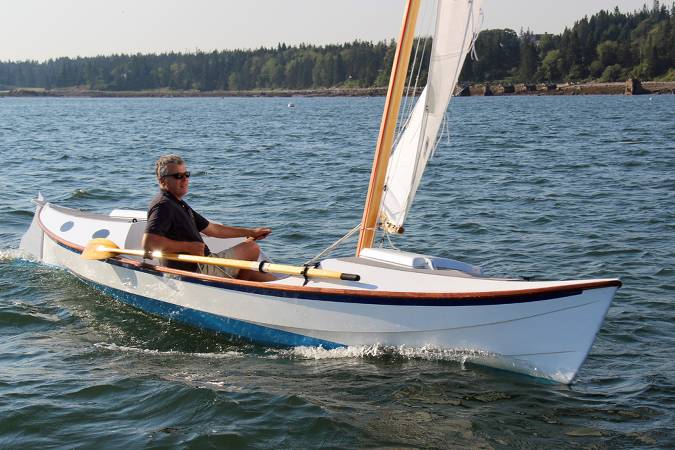












Product Description
A serious rowing and sailing boat for coastal cruising, with a small cabin aft. It is a functional boat combining modern building methods with a traditional stylish clinker hull shape.
Faerings are the indigenous smallcraft of Scandinavia, direct descendants of the Viking ships that raided and traded throughout Europe starting more than a thousand years ago. Light but strongly built, the distinctive double-ended hulls feature a sweeping sheer-line, lapstrake planking and a narrow waterline for speed under oars and sail.
The traditional faerings were, like the Viking ships, built by fastening overlapping lapstrake planks together with rivets and then adding internal frames for strength. This Nordic boatbuilding method produced lighter boats than the more common method of building a frame and then covering it with planking. The elegant hull shape of the Norwegian faering adapts well to the modern stitch-and-glue method, in which pre-fabricated plywood panels are joined at their edges to create a light and stiff hull with minimal framing.
Boat designer John Harris created a 19′8″ stitch-and-glue faering for beach cruising with one or two sliding-seat rowers. Four of them have been built, but unfortunately there hasn't been time to create the elaborate instruction manual that would make construction accessible to amateurs. However, John used it as the basis for the Faering Cruiser, a longer boat with a small cabin and a sailing rig but still with enough space amidships for a sliding seat rowing rig.
The hull, cockpit and interior framing is mostly 9 mm Okoume plywood and the decks are 6 mm Okoume plywood. With the pre-cut panels in the kit, assembly is very quick. CLC's LapStitch process yields a hull that is stiff, light, beautiful and quick to build.
While 22′6″ of overall length sounds big, this is actually a fairly compact camp-cruiser, weighing only about 650 lb on the trailer. It tows effortlessly behind small cars.
The cabin is comfortable, if cosy; similar to sleeping in a good one-man tent. The advantages over an open boat are that your gear and bedding stay dry no matter what the weather's doing, the sealed compartment provides a great deal more safety in a capsize and you have lockable stowage.
Several rig options were considered before settling on a single balanced lug sail. The sail area is modest, but the hull is very easily driven. The boat is fast, jumping up to 6 knots in 12 knots of wind. 270 lb of water ballast beneath the self-bailing cockpit floor settles the boat right down, though a reef is needed once whitecaps appear unless you're trying to win a race. The pivoting centreboard allows nice balance and excellent upwind ability. The rudder is connected to the tiller with stainless steel cables that run through baffled vents in the cabin (no leaks to worry about). Flipping the tiller up locks the rudder on the centre line for rowing.
With a sliding seat and long sculls, a rower of modest strength and ability can move the boat upwind easily enough, although you're likely to be sailing if there's a long way to go to windward. In a flat calm, it's easy to imagine a 25-mile day under oars alone. We might consider eliminating the sliding-seat option and using shorter oars with a fixed seat. Speed would suffer a little, but there would be no need to stow a sliding seat and oar storage would be improved. Lazy jacks lift the furled boom and yard to clear the cockpit for rowing. A tabernacle scheme for lowering the mast is suggested, but it's fairly complex and will add weight.
As a coastal cruiser, this design offers many advantages: a dry berth, lots of storage and excellent speed under sail and oars. We suspect that many builders would be moving up to this design from kayaks or small rowing boats, seeking more comfort and stowage while maintaining a small footprint on the coastal trail.

The hull kit includes:
- Pre-cut wooden hull panels with pre-cut puzzle joints and pre-drilled tie holes
- Rudder, centreboard and centreboard case
- Solid timber stock for rails, stringers and cleats
- Epoxy resin and activator
- Epoxy fillers
- Copper ties
- Woven glass fabric
- Woven glass tape
- Plans suitable for experienced builders
- Free technical support from a competent builder
Hardware, rowlocks, sliding seat hardware, spars, sail and rigging are not included in this base kit package. This boat is designed for use with a sliding seat, the parts for which are not included in the kit.
While the kit will go together quickly for someone who can read plans and has some experience building larger-scale wood-epoxy composite boats, this is not a project for first-time boatbuilders.
This kit weighs a lot and requires a specialised courier. The price of delivery will vary with your address. You are, of course, very welcome to collect the kit from our Lake District workshop.
Plans (not required by kit purchasers)
The plans contain sufficient information to build the boat from scratch rather than a kit. Despite the stitch-and-glue construction method, the Faering Cruiser is not for first-time boat-builders. Professionals and experienced amateurs will find it a fast and straightforward build, but you'll need to have good plans-reading ability and a couple of wood-epoxy composite boats under your belt before diving in.
The plans include 17 pages of architectural drawings and full-size templates for every part in the boat except the hull planking and decks. There are pages devoted to the rigging of the tiller, hatches and other peculiarities of the design.
PDF study plans
An 8-page set of study plans in PDF format that can be viewed using Adobe Reader. After credit card authorisation the file will be sent to the email address put on the order form. Nearly all details are shown, providing a good overview of the boat and it's construction.
These study plans are intended for pre-build study or to help with the decision to purchase. It is not possible to build the boat from scratch using only these plans.




